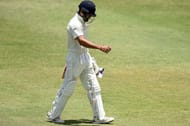Virender Sehwag was a maverick! Viru, as he is fondly referred to by fans and friends alike, was a once in a century batsman, especially in the game’s oldest, longest and toughest format. There was never a successful Test opener like him in India and there probably never will be. In his approach to opening the batting in Test matches, that is.
As the cliché goes, he came, he saw, he conquered.
At the peak of his prowess, he would invariably hit the first ball of a Test match for four, dispatch the last ball before lunch to the boundary or move from 94 to 100 or 194 to 200 or even 294 to 300 with a six. And every time you would quiz him on his unorthodox methods, he would retort saying he was just playing his ‘natural game’.
If you were watching the present Indian Test batting unit bat on day one of India’s three-Test home series against New Zealand, you would feel that most of them have grown up idolizing Viru’s Test batting philosophy. It is another matter that all of them would say ‘Sachin’ or ‘Dravid’ when asked publicly, but their actions certainly do not back their words.
What no one probably told them was that there will only ever be one Viru. If you want to make it to the annals of Test batting greatness, you would emulate his philosophy at your peril.
Also Read: India vs New Zealand 2016: Hosts unhappy with Kiwis breaching the spirit of Cricket
Take the hook shot Virat Kohli played to Neil Wagner off the 10th ball he faced. It was clear that Wagner had a plan to bowl short at him early on. He had bowled a couple short to him already and Kohli had exposed his intentions to go after the short ball- as is ‘natural game’ or instinct.
But this time, Wagner had gone over the wicket instead of round, and made the angle for the hook all the more difficult. Virat, who is now 46 Test matches old and captain to boot, still fell for the trap, went for the hook nevertheless, top-edged to hole out to deep square leg, strategically placed for this very possibility. The lesser said about Rohit Sharma’s ‘rich’ Test dismissals the better.
But what irks connoisseurs is when Murali Vijay defends these instincts in the daily post-play press conference, saying these are their scoring areas and methods and that one should stick to methods which got them this far.
Did this bunch ever watch the Sachin Tendulkar double hundred in Sydney, where he did not play a single shot on the off-side to eliminate his options of getting out completely?
Matthew Hayden rediscovered himself as a Test batsman in India when he played the sweep shot to telling effect to counter the Indian spinners and score heaps of runs. He had never played that shot with so much regularity either prior to that tour or ever after. Was that his ‘natural game’?
Also Read: SK Players of the day: Kane Williamson and Tom Latham's fluent show on Day 2 of the Kanpur Test
Sourav Ganguly’s batting preparations for that famous away Test series in Australia in 2001-02 involved going against his grain and moving on to the front foot at the point of delivery- a subtle adjustment which led to that epoch hundred at the Gabba and the rest, as they say, is history. When VVS Laxman used to play with the tail, he would be far more circumspect with shot making than his natural instincts urged him to be.
Chances are, the present crop of Indian Test batsmen have learnt nothing from the former greats of the game and focussed on just one- who was an exception, not the rule. No wonder then that none of them have been able to touch the ‘Great Test Batsman’ benchmark average of 50 thus far.
If they had learnt from the former greats, they would know that Test batting is not all about their ‘natural game’.
It is actually more about curbing your natural instincts to the benefit of your team’s cause. It is about adjusting to the conditions, which change every day and with every session, about adjusting to various bowling attacks; above all adjusting to the context of the game.
It is different in the shorter formats because you have a limited amount of time and overs to achieve what you have to achieve, that too on that very day. In Test matches, you have the license to bat for two days or more if you want to.
Also Read: Dazzlers in Colour, Pale in Whites: Rohit Sharma and Martin Guptill
In Test matches, you bat time, you bat to mentally disintegrate the opposition. When you are battling for your country, you do not do what naturally comes to you. You do what is necessary to get the best result for your country.
Is there a sense of complacency? Maybe, given their number two ranking and recent Test series wins. They need to remember though that rankings can be misleading and performances against settled Test teams like New Zealand or England would be much more difficult than against rebuilding, rebellious or unsettled Test teams if they do not get the basics of Test cricket right and continue to make the same mistakes.
The good part is that most of the current Indian Test batsmen are still comparatively young. Not very young anymore though and certainly very experienced in international cricket, but given that they are just about approaching that age when Test batsmen are at their best, we all hope, in the best interests of India’s future Test cricket fortunes, that they will learn quicker than they have thus far.
Brand-new app in a brand-new avatar! Download CricRocket for fast cricket scores, rocket flicks, super notifications and much more! 🚀☄️

